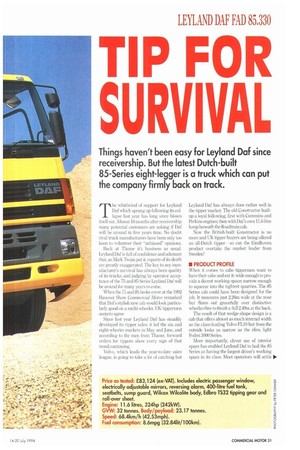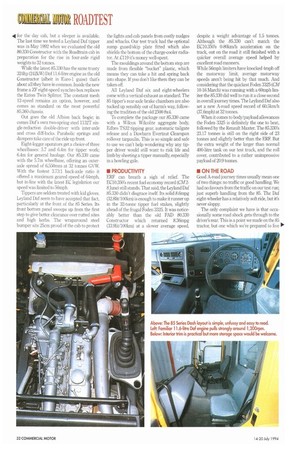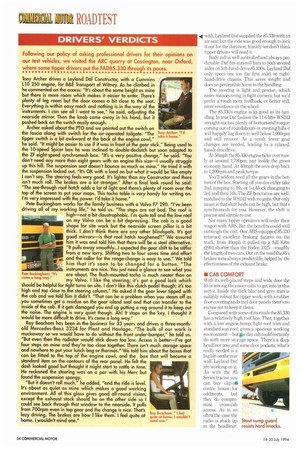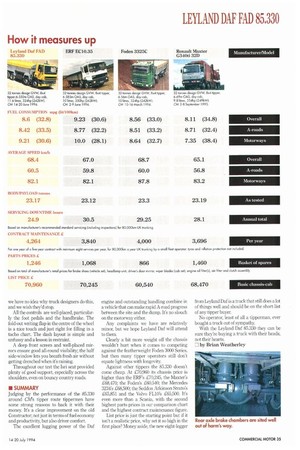TIP FOR
Page 33

Page 34

Page 36

Page 37

If you've noticed an error in this article please click here to report it so we can fix it.
SURVIVAL
Things haven't been easy for Leyland Daf since receivership. But the latest Dutch-built 85-Series eight-legger is a truck which can put the company firmly back on track.
The whirlwind of support for Leyland Daf which sprang up following its collapse last year has long since blown itself out, Almost 16 moil' lis after receivership many potential customers are asking if Daf will be around in five years time. No doubt rival truck manufacturers have been only too keen to volunteer their "unbiased" opinions.
Back at Thame it's business as usual. Leyland Oaf is full of confidence and adamant that, as Mark Twain put it, reports of its death are greatly exaggerated. The key to any manufacturer's survival has always been quality of its trucks, and judging by operator acceptance of the 75 and 85 Series Leyland Oaf will be around for ninny years to come.
When the 75 and 85 broke cover at the 1992 Hanover Show Commercial Motor remarked that Oaf's stylish new cab would look particularly good on a multi-wheeler. UK tippermen seem to agree Since last year Leyland Daf has steadily developed its tipper sales: it led the six and eight-wheeler markets in May and June, and according to the men from Thame, forward orders for tippers show every sign of that trend continuing.
Volvo, which leads the year-to-date sales league, is going to take a lot of catching but Leyland Daf has always done rather well in the tipper market. The old Constructor builtup a loyal following, first with Cummins and Perkins engines: then with Oaf's own 11.6-litre lump beneath the Roadtrain Now the British-built Constructor is no more and UK tipper buyers are being offered an all-Dutch tipper so can the Eindhoven product overtake the market leader from Sweden?
• PRODUCT PROFILE When it conies to cabs tippermen want to have their cake and eat it: wide enough to provide a decent working space; narrow enough to squeeze into the tightest quarries. The 85 Series cab could have been designed for the job. it measures just 2.26m wide at the nose but flares out gracefully over distinctive wheelarches to finish a full 2.49m at the back.
The result of that wedge-shape design is a cab that offers almost as much internal width as the class-leading Volvo FL10 but from the outside looks as narrow as the slim, light Foden 3000 Series.
More importantly, clever use of interior space has enabled Leyland Dal' to hail the 85 Series as having the largest driver's working space in its class. Most operators will settle 111. for the day cab, but a sleeper is available, The last time we tested a Leyland Daf tipper was in May 1992 when we evaluated the old 80.330 Constructor with the Roadtrain cab in preparation for the rise in four-axle rigid weights to 32 tonnes.
While the latest 85.330 has the same trusty 324hp (242kW) Daf 11.6-litre engine as the old Constructor (albeit in Euro-1 guise) that's about all they have in common, Inside the new frame a ZF eight-speed synchro box replaces the Eaton Twin Splitter, The constant mesh 12-speed remains an option, however, and comes as standard on the most powerful 85.360 chassis.
Out goes the old Albion back bogie; in comes Des own two-spring steel 1132T single-reduction double-driver with inter-axle and cross duff-locks. Parabolic springs and dampers take care of the ride up front.
Eight-legger operators get a choice of three wheelbases: 51 and 6.4m for tipper work; 6.4m for general haulage. Our 85.330 came with the 51m wheelbase, offering an outeraxle spread of 6,550mm at 32 tonnes GVW. With the fastest 3.73:1 back-axle ratio it offered a maximum geared speed of 64mph, but in-line with the latest EC legislation our speed was limited to 56mph.
Tippers are seldom treated with kid gloves. Leyland Daf seem to have accepted that fact, particularly at the front of the 85 Series. Its front bottom panel sweeps up from the first step to give better clearance over rutted sites and high kerbs. The wraparound steel bumper sits 25cm proud of the cab to protect the lights and cab panels from costly nudges and whacks. Our test truck had the optional sump guard/skip plate fitted which also shields the bottom of the charge-cooler radiator. At £119 it's money well-spent.
The mouldings around the bottom step are made from flexible "bucket" plastic, which means they can take a hit and spring back into shape. If you don't like them they can be taken off.
All Leyland Daf six and eight-wheelers come with a vertical exhaust as standard. The 85 tipper's rear-axle brake chambers are also tucked up sensibly out of harm's way, following the tradition of the old 2500 8x4.
To complete the package our 85.330 came with a Wilcox Wilcolite aggregate body, Edbro TS32 tipping gear, automatic tailgate release and a Dawbarn Evertaut Clearspan rollover tarpaulin. This is so simple and safe to use we can't help wondering why any tipper driver would still want to risk life and limb by sheeting a tipper manually, especially in a howling gale.
• PRODUCTIVITY
ERF can breath a sigh of relief. The EC10.350's recent fuel economy record (CM28June) still stands. That said, the Leyland Daf 85230 didn't disgrace itself. Its solid 8.6mpg (32.81it/100km) is enough to make it runner up in the 32-tonne tipper fuel stakes, slightly ahead of the frugal Foden 3325. It was noticeably better than the old FAD 80.330 Constructor which returned 8.36mpg (33.91it/100km) at a slower average speed, despite a weight advantage of 1.5 tonnes. Although the 85.330 can't match the EC10350's 0-80km/h acceleration on the track, out on the road it still finished with a quicker overall average speed helped by excellent road manners.
While 56mph limiters have knocked 4mph off the motorway limit, average motorway speeds aren't being hit by that much. And considering that the quickest Foden 3325 (CM 10-16 March) was running with a 60mph limiter the 85330 did well to run it a close second in overall journey times. The Leyland Daf also set a new A-road speed record of 60.5km/h (37.6mph) at 32 tonnes.
When it comes to body/payload allowances the Foden 3325 is definitely the one to beat, followed by the Renault Maxter. The 85.330's 23.17 tonnes is still on the right side of 23 tonnes and slightly better than the ERF. But the extra weight of the larger than normal 400-litre tank on our test truck, and the roll cover, contributed to a rather unimpressive payload of 20.9 tonnes.
III ON THE ROAD
Good A-road journey times usually mean one of two things: no traffic or good handling We had no favours from the traffic on our test run; just superb handling from the 85. The Daf eight-wheeler has a relatively soft ride, but its never sloppy.
The only complaint we have is that occasionally some road shock gets through to the driver's rear. This is a point we made on the 85 tractor, but one which we're prepared to live It'
with. Leyland Daf supplied the 85.330 with an air seat but the ride was good enough to lock it out for the duration; frankly we don't think tipper drivers will need it.
Body roll is well controlled and always predictable. Daf fits anti-roll bars to both steered axles on left-hand-drive 85.330s. Leyland Daf only specs one (on the first axle) on righthand-drive chassis. This saves weight and does no perceptible harm to the handling.
The steering is light and precise, which eases manoeuvring in tight corners, but we'd prefer a touch more feedback, or better still, more resistance on the wheel.
The 85.330's engine is as good as its handling. In true Daf fashion the 11.6-litre WS242 straight-six has plenty of bottom-end torque: coming out of roundabouts or cresting hills it will happily lug down to well below 1,000rpm and still recover. As a result fewer gear changes are needed, leading to a relaxed, hassle-free drive.
At 56mph the 85.330 engine ticks over nicely at around 1,700pm, just inside the green economy band. At 40mph the revs drop back to 1,200rpm and peak torque.
You'll seldom need all the gears in the bottom of the box. Starting off you can either take 2nd, jumping to 4th, or 1st block changing to 3rd and then 5th. The ZF box ratios are well. matched to the WS242 with no gaps. Our only moan is that shift loads can be high, but that's synchromesh for you. However, the shift is precise and simple to use.
Not many tipper operators will order their wagon with ABS. But the benefits could well outweigh the cost. Our ABS-equipped 85.330 returned excellent braking figures on the track; from 40mph it pulled up a full 8.8m 129ft) shorter than the Foden 3325--roughly the length of two cars. Out on the road the 85's brakes were always predictable, helped by the effectiveness of the exhaust brake.
• CAB COMFORT
With its well-placed steps and wide door the 85 is among the easier cabs to get into in this sector. Inside the dark blue and grey trim is suitably robust for tipper work; with a rubber floor covering and vinyl door panels there's no excuse not to keep it clean.
Compared with some of its rivals the 85.330 has a relatively high roof line. That, together with a low engine hump, light roof trim and standard sun roof, gives a spacious working environment—butte day cab could certainly do with more storage space. There's a deep headliner tray and some door pockets; what's really needed is a big bin on the rear wall. Leyland Daf are working on it. As with the 85 Series tractor you can buy clip-o• centre boxes for oddments, but they do compromise cross-cab access. As is so often the case the radio is stuck up Stout sump guard in the headliner: resists hard knocks.
we have no idea why truck designers do this, and we wish they'd stop.
All the controls are well-placed, particularly the foot pedals and the handbrake. The fold-out writing flap in the centre of the wheel is a nice touch and just right for filling in a tacho chart. The dash layout is simple and unfussy and a lesson in restraint.
A deep front screen and well-placed mirrors ensure good all-round visibility; the half side-window lets you breath fresh air without getting drenched when it's raining.
Throughout our test the Isri seat provided plenty of good support, especially across the shoulders, even on bouncy country roads,
• SUMMARY
Judging by the performance of the 85.330 around Gifs tipper route tippermen have some strong reasons to back it with their money. It's a clear improvement on the old Constructor; not just in terms of fuel economy and productivity, but also driver comfort.
The excellent lugging power of the Daf engine and outstanding handling combine in a vehicle that can make rapid A-road progress between the site and the dump. It's no slouch on the motorway either.
Any complaints we have are relatively minor, but we hope Leyland Daf will attend to them.
Clearly a bit more weight off the chassis wouldn't hurt when it comes to competing against the featherweight Foden 3000 Series, but then many tipper operators still don't equate lightness with longevity.
Against other tippers the 83.330 doesn't come cheap. At £70,960 its chassis price is higher than the ERF's £70,245, the Maxter's £68,470; the Foden's .£60,540; the Mercedes 3234's £68,500; the Seddon Atkinson Strato's £65,851 and the Volvo FL10's £65,500. It's even more than a Scania, with the second highest parts prices in our comparison chart and the highest contract maintenance figure.
List price is just the starting point hut if it isn't a realistic price, why set it so high in the first place? Money aside, the new eight-legger from Leyland Daf is a truck that still does a lot of things well and should he on the short-list of any tipper buyer.
No operator, least of all a tipperman, ever bought a truck out of sympathy.
With the Leyland Daf 85.330 they can be sure they're buying a truck with their heads, not their hearts.
El by Brian Weatherley




























































































